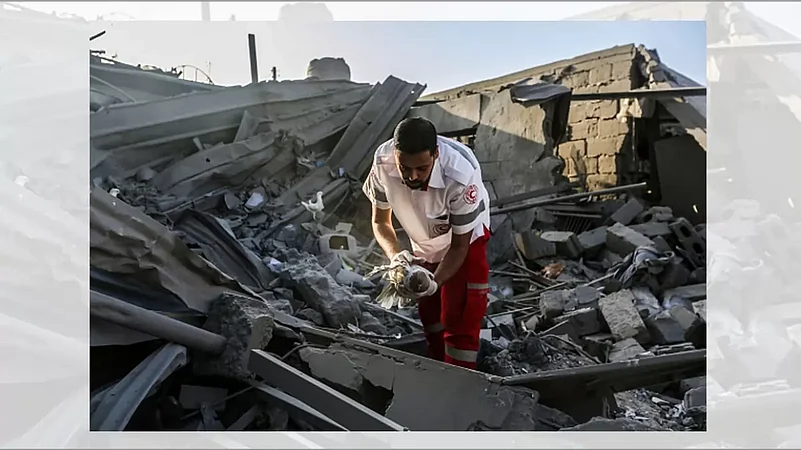After 45 days of devastating destruction in Gaza, Israel and Hamas agreed on Wednesday to a temporary four-day halt on all military actions to allow the release of 50 hostages held by the militant group in exchange for 150 Palestinian detainees in Israel and the entry of humanitarian aid into the besieged territory.
Qatar, whose capital, Doha, serves as the headquarters for Hamas, confirmed that an agreement for a temporary ceasefire had been reached, and it will start in the next 24 hours. Qatar’s foreign ministry described the talks as a mediation effort by Egypt, the US and Qatar for a “humanitarian pause”.
However, Israel's national security adviser later said that the ceasefire talks with Hamas were still ongoing and the hostage release would not take place before Friday.
Several concerned Arab countries — including Jordan and Egypt, which made peace with Israel decades ago — have also called for a broader ceasefire in the war, while the United States had been trying to secure a humanitarian pause.
The death toll in Gaza climbed over 13,000. Countries and humanitarian groups across the world are increasingly demanding to ease the sufferings of Gazans, many of whom are making ends meet with the last shred of their essential resources and hope. The Israeli military’s ground forces have been fighting in “the depths” of Gaza City, signalling the beginning of a new stage by the Israeli military as it moves in toward what it says is the headquarters and stronghold of the Hamas militant group.
Despite the consensus around helping those in need, the debate now lies between countries calling for a ‘humanitarian pause’, and humanitarian groups urging for a ‘ceasefire’. While both these terms involve a break in fighting, the difference largely lies in how long this break would be. Let us explain how.
What is the difference between the two?
Humanitarian pause
According to the United Nations, a humanitarian pause is a temporary cessation of hostilities purely for humanitarian purposes. Requiring the agreement of all relevant parties, it is usually for a defined period and specific geographic area where the humanitarian activities are to be carried out.
Such a pause would allow the delivery of essential humanitarian aid such as food, fuel and medicines, and would also permit civilians to flee to safe zones. The United States, which has so far supported Israel in what it says is its ‘right to self-defence’, has advocated for a humanitarian pause in the war. However, Israel has rejected these suggestions. U.S. Secretary of State Antony Blinken told reporters that Israel has raised "important questions" about how humanitarian pauses would work, and the U.S. is working to answer them.
However, humanitarian groups believe that such a pause might not be enough in the strife-torn region. According to a recent report by Oxfam, such pauses can sometimes put civilians in greater risk as they might not have access to credible information about what is a ‘safe’ zone and what is not. Further, many such ‘safe zones’ that were demarcated by Israel itself were bombed and attacked in the last month – for example, Nuseirat Refugee Camp in Gaza which was hit by an Israeli airstrike.
Palestinians in Gaza fear that talk of forcing them into humanitarian corridors and safe zones is really an attempt to remove them permanently from their land to a new location, as has happened throughout their history, the Oxfam report says.
The organisation also notes that there should not even arise a need for such humanitarian corridors, pauses or safe zones to ensure delivery of life-saving aid as international humanitarian law makes it illegal to target civilians, or deny them humanitarian relief supplies.
Apart from the United States, the European Union, Saudi Arabia and the United Nations are calling for a “pause” in the fighting to at least provide temporary humanitarian relief to the people of Gaza.
Ceasefire
According to the United Nations, a ceasefire is a suspension of fighting agreed upon by the parties to a conflict, typically as part of a political process. It is intended to be long-term and often covers the entire geographic area of the conflict. Its aim is usually to allow parties to engage in dialogue, including the possibility of reaching a permanent political settlement.
In the current case, the ceasefire would cover not just the Gaza strip but also the south of Lebanon where Israeli troops are battling with Hezbollah and other areas affected by the conflict.
However, just like a humanitarian pause, a ceasefire doesn’t imply a permanent peace agreement or a permanent end to the war. But rather, regulates the cessation of all military activity for a given length of time in a given area which would then create conditions for a permanent peace agreement.
The Oxfam report says that given the scale of the need, a ceasefire is the only solution that works. Such a ceasefire will also be an essential precursor to peace talks and addressing the root causes of the conflict, the report notes.
While western leaders resisted the ceasefire call, the Arab Group of countries has made a united call to the United Nations for a ceasefire in Gaza. In October, the US also vetoed a United Nations Security Council resolution that would have condemned Hamas’ attack on Israel while calling for a pause in the fighting to allow humanitarian assistance into Gaza.
The US was the sole vote against the resolution, with 12 members voting in favour and Russia and the United Kingdom abstaining.
















